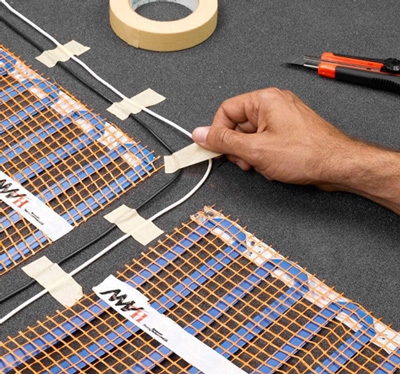
Under floor heating has a long and rich history. The first known use of underfloor heating was in Roman times. The Romans used a heating system that warmed the floors of their homes with heat from cooking and water heating. Over 2500 years ago, the Koreans also used a similar heating system. They installed an exhaust system under the floors of their houses and placed the stove at one side of the house and the chimney at the other. The passing of the warm air under the floor of the house heated the house from the ground up. Since that time, many other advances have been made in the use of underfloor heating. Although the practice was abandoned for some time, today’s resurgence of eco-friendly lifestyles and a desire to get back to old ways of living has stirred up a renewed interest in the practice.
The development of the modern system
Today’s modern radiant floor heating uses similar practices as the original Roman and Korean designs, but with many additional safety features. One of the first people to introduce the concept to the modern world was the architect Frank Lloyd Wright. He realized that you could heat the floor from below by heating water inside small pipes placed under the floor for a safer heating technique than that used by the Romans and Koreans. Today, other versions of radiant heating exist, including heating with water, air, and electric coils that produce a similar effect to an electric stove. Through the years, people continued to add new innovations to the design that has transformed under floor heating into one of the most efficient home-heating systems available today.
Benefits of underfloor heating
A home that has under floor heating actually has many advantages over a home that does not. Radiant heating allows each object inside the room to become warmed individually from the inside out, rather than from the outside in. Other forms of heating, such as heated air systems, warm the air itself rather than the objects inside a room. This is actually much harder to maintain than the type of heat that radiant heating produces, which leads to more energy consumption in the process of maintaining the desired heat level inside the room. Radiant heat is also less expensive to run than some other forms of home heating because the system is self-contained. Water-heated systems are the least expensive, because they simple reuse the same water and heat it over and over again to keep the floors of a home warm. Even electric under floor heating systems are often more efficient than other home heating systems because the units are insulated under the house and near the ground, which helps retain heat.
Problems with under floor heating
Although there are many benefits to the system, there are a few drawbacks as well. If your home was not built with a radiant floor heating system already in place, it is extremely difficult to add at a later date. The expense of adding a radiant floor system to an existing house is also costly. Not all home types can use radiant heating. Radiant heating works best with homes that have concrete foundations.
Although there are a few problems with the concept and implementation of underfloor heating, the benefits typically outweigh the drawbacks. If you are considering the purchase of a new home or are building your own, consider the cost and energy benefits that using a radiant floor heating system could provide over the years. A built-to-last under floor heating system will continue to provide excellent heating power for many years to come.
This is a guest post by John Millington. John currently represents Underfloorheating1.co.uk the a leading specialist in wet and electric underfloor heating.










Comments